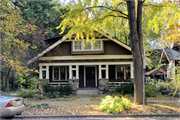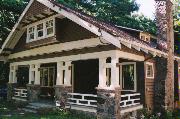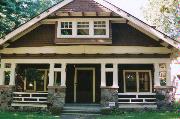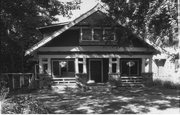| Additional Information: | A 'site file' exists for this property. It contains additional information such as correspondence, newspaper clippings, or historical information. It is a public record and may be viewed in person at the Wisconsin Historical Society, State Historic Preservation Office.
EUGENE C. SMITH WAS THE BUILDER AND J. ALLEN COOMBS THE CARPENTER CONTRACTOR.
Between 1900 and the 1930s, a mania for Craftsman bungalows swept the country, spreading from California and the West to the Midwest and beyond. Bungalow plans soon became widely available in builders' pattern books, helping to make these houses affordable to middle-class homeowners, who liked the bungalow’s rustic craftsmanship, open plans, and broad front porches. Even popular songs lauded the economical yet homey bungalow.
In 1909, Cora Cadwallader Tuttle introduced the Craftsman bungalow to Madison when she built this house. Tuttle had just returned from a stay in Arizona, where Craftsman bungalows had already caught on, and designed one for herself, with the assistance of her son Ray, an engineering student. Tuttle’s design was based on recollections of houses she had seen in Arizona, and it became a prototype for later bungalows in Madison. Hoping to profit from the bungalow craze, local companies donated materials or offered special discounts to help build her home. The Rayne Lumber Company, for example, used the house to demonstrate rough-cut siding for exterior cladding and quarter-sawn oak for interior woodwork.
Between 1910 and 1914, Tuttle designed several more California bungalows, four near her own home (at 1202 Grant St. and 1811, 1813, and 1821 Vilas Ave.), some of which she planned in collaboration with her nephew E. C. Smith. She also designed a group of bungalows at 841 Prospect Place and at 416-420 Russell Walk. She thereby became the only woman known to have designed buildings professionally in Madison before World War I.
Tuttle's rustic design is an outstanding expression of the Craftsman style. The inset porch dominates the facade. Rising from stone piers, twinned wooden columns joined by horizontal braces support the front-facing gable sheltering the porch. A rectangular oriel with a ribbon of windows projects from the gable's face, clad with wooden shingles. The wide trim framing the gable comes to an extended point at the apex. Exposed rafter tails and purlins are painted in contrasting colors, and ribbons of windows and a wooden porch railing complete the design. The dormer facing Vilas Park was added in 1926. The original pergola over the patio has been removed.
City of Madison, Wisconsin Underrepresented Communities Historic Resource Survey Report:
Cora Tuttle was born Cora Cadwallader in 1864 near Evansville, Wisconsin. She married Charles M. Tuttle in 1890, and by 1900 was living in the Town of Brooklyn, Wisconsin. In 1904 Cora, Charles, their nephew Eugene Cadwallader Smith moved to Ganado, Texas. Charles died there in 1906. By that time, Cora had three sons, and her nephew Eugene had moved to Prescott, Arizona. After Charles died, Cora moved to Prescott with her sons to live with Eugene’s family. By 1908, Cora and her son's Ray, Clifton, and Fordyce moved to Madison, so Ray could attend engineering school at the University of Wisconsin. Tuttle, with no formal architectural training, designed a Bungalow for her own family. In 1909, she assembled craftspeople to build a house for herself at 1206 Grant Street.
The house was unique in Madison and drew on Tuttle’s understanding of the Bungalow style as refined by architects in California, a style she had likely been exposed to while living in the southwest. The building introduced the style to Madison. Tuttle was the first known woman architectural designer in Wisconsin, and the only known woman to be designing buildings in Madison before the 1930s. The first licensed woman architect in the state was Lillian Leenhouts of Milwaukee, who began practicing in her family’s office in 1942.
Tuttle gained a reputation for designing bungalows at a time when the style was becoming widely popular nationwide and in Madison. Over the next twenty years, Cora Tuttle designed about fifteen more homes that were built in the city, often in collaboration with her son Ray, who had studied structural engineering, and her nephew Eugene, who had returned to Madison in 1911 to care for his aging parents. Cora Tuttle lived in the house at 1206 Grant Street until she left Madison around 1931 and moved to Rochester, New York. She died in 1948.
Cora Tuttle is locally significant in the area of Architecture from 1909 to 1931. During this time, she lived in the house at 1206 Grant Street. |
|---|





